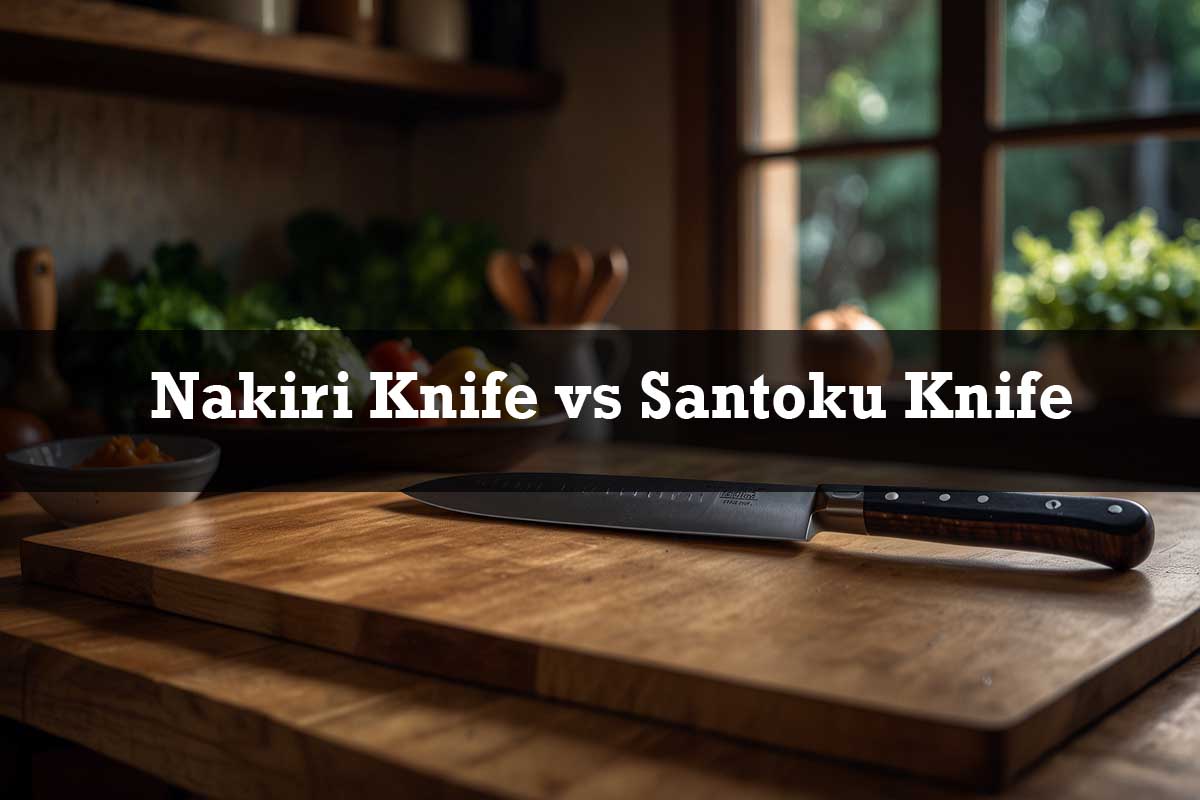Nakiri Knife vs Santoku Knife: Key Differences and Best Uses

When it comes to Nakiri Knife vs Santoku Knife, both have earned their place in professional and home kitchens. These Japanese knives are known for their precision and versatility, making them favorites among chefs and cooking enthusiasts. But what sets them apart?
This article will delve into the key differences between these two types of knives, helping you make an informed choice for your kitchen needs. Understanding the unique features and uses of each will guide you to pick the best kitchen knives for your cooking style. Let’s discuss this Japanese knives comparison to see which one suits you best.
What is a Santoku Knife?
The Santoku knife is a staple in many kitchens, originating from Japan. The name “Santoku” translates to “three virtues,” referring to its proficiency in three main tasks: chopping, dicing, and mincing. This versatility makes it a favorite for various culinary tasks.

Physically, the Santoku knife typically has a blade length ranging from 5 to 8 inches. The blade is slightly curved, allowing for a rocking motion while cutting, and it often features a Granton edge. This edge, characterized by small indentations along the blade, helps prevent food from sticking, enhancing the knife’s efficiency.
Benefits of a Santoku Knife
The Santoku knife benefits are numerous, making it a versatile kitchen knife that many cooks appreciate. Here are some key advantages:
- Versatility: Perfect for cutting vegetables, meats, and fish, covering a broad range of kitchen tasks.
- Precision: The sharp, thin blade allows for precise cuts, ensuring even and aesthetically pleasing food preparation.
- Non-stick features: The Granton edge minimizes food sticking to the blade, making the cutting process smoother and more efficient.
With its balance of versatility and precision, the Santoku knife is a reliable tool in any kitchen.
What is a Nakiri Knife?
The Nakiri knife is another essential tool in Japanese cuisine, specifically designed for cutting vegetables. Its most distinctive feature is the straight edge and squared-off tip. This design is ideal for making clean, consistent cuts through vegetables.

As a Japanese vegetable knife, the Nakiri knife excels in efficiency. The straight edge ensures that the entire blade comes into contact with the cutting surface, making it perfect for push-cutting techniques. This results in precise, uniform slices, which is particularly useful when preparing intricate vegetable dishes.
Benefits of a Nakiri Knife
The Nakiri knife benefits from a design that caters specifically to vegetable preparation. Here are its primary advantages:
- Specialized design for vegetables: The straight, flat edge is perfect for chopping vegetables without the need for a rocking motion.
- Precision: It provides consistent, clean cuts, ideal for delicate vegetable work.
- Ease of use: The unique blade shape facilitates a straightforward chopping motion, making it easier to achieve perfect cuts.
For anyone focused on vegetable preparation, the Nakiri knife is undoubtedly the best knife for vegetables. Its specialized design and precision make it a valuable addition to any kitchen.
See more: Carbon Vs Stainless Steel Knife
Nakiri Knife vs Santoku Knife: A Detailed Comparison
When it comes to choosing between a Nakiri knife and a Santoku knife, understanding the differences can help you make the best choice for your kitchen. Let’s break down the Nakiri Knife vs Santoku Knife comparison across several key aspects.
Blade Length
- Nakiri Knife: Typically has a blade length of 6 to 7 inches.
- Santoku Knife: Usually features a blade length of 5 to 8 inches.
Design
- Nakiri Knife: Straight edge with a squared-off tip, ideal for push-cutting.
- Santoku Knife: Slightly curved edge with a rounded tip, suitable for a rocking motion.
Best Uses
- Nakiri Knife: Specialized for cutting vegetables, providing clean and consistent cuts.
- Santoku Knife: Versatile for cutting vegetables, meats, and fish, making it a multi-purpose tool.
Cutting Technique
- Nakiri Knife: Designed for a push-cutting technique, where the entire blade contacts the cutting surface.
- Santoku Knife: Suitable for both chopping and rocking motions, allowing for more varied cutting techniques.
Sharpness
- Nakiri Knife: Typically features a very sharp, thin blade that excels in making precise vegetable cuts.
- Santoku Knife: Also very sharp, with a thinner blade than most Western knives, offering precision across different types of food.
Comparison Chart
| Aspect | Nakiri Knife | Santoku Knife |
|---|---|---|
| Blade Length | 6 to 7 inches | 5 to 8 inches |
| Design | Straight edge, squared-off tip | Slightly curved edge, rounded tip |
| Best Uses | Cutting vegetables | Cutting vegetables, meats, and fish |
| Cutting Technique | Push-cutting | Chopping and rocking motion |
| Sharpness | Sharp, thin blade for precision vegetable cuts | Sharp, versatile blade for various foods |
Understanding these differences between Nakiri and Santoku knives can help you determine which knife best suits your cooking style and needs. Both knives have their strengths, and choosing the right one depends on the tasks you prioritize in your kitchen.
Also know: Curved vs Straight Boning Knife
FAQs on Nakiri Knife vs Santoku Knife
Final Thoughts
In the Nakiri Knife vs Santoku Knife comparison, each knife has its strengths. The Nakiri knife excels at precise vegetable cuts with its straight edge and squared tip.
The Santoku knife offers versatility, handling vegetables, meats, and fish with ease. When choosing the right knife, consider your primary cooking tasks.
If you mainly prepare vegetables, a Nakiri knife is ideal. For a multi-purpose tool, the Santoku knife is a great choice. Both are excellent additions to any kitchen, depending on your needs.
